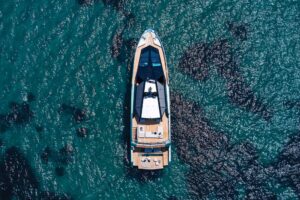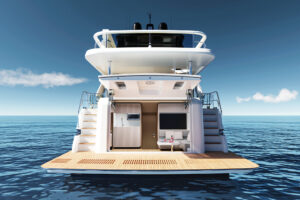For some, the destination is everything. For others, the journey is a goal in itself. For Steve Scarpa, the design and construction of his new yacht, the first 92-footer from Horizon Yachts, was an immensely satisfying, as well as a totally consuming, project.
A Northern California real estate entrepreneur, Scarpa immersed himself in the project from the moment he decided to step up from co-ownership of an 80-footer. “I can honestly say that I looked at every yacht in the 90-foot range, both to see how well they used the space and to decide on a builder”, Scarpa said.
He filled books with notes, drawings and photos, and after exploring literally dozens of yachts, knew two things for sure: “First, most builders waste immense amounts of space, and second, I knew Horizon could and would build the yacht the way I wanted it.”
Since Scarpa’s plans include extensive personal cruising from Mexico to Alaska as well as future chartering, the yacht had to be ruggedly built. The yacht is named Maximus, ostensibly after Scarpa’s tough cat, but more likely referring to the owner’s quest to maximize the living space. The 92 (like other Horizon yachts from 60 to 113 feet) is built with Scrimp, a sophisticated resin-infusion process developed by the U.S. Navy to create fiberglass yachts with maximum strength and minimum weight.
Horizon offers several interior arrangements but sells each boat as “completely customized. That claim is certainly true with Maximus. Starting with the 92-foot hull, Scarpa used the entire 21-foot beam to create expansive interior space with a wide-body superstructure that narrows forward to allow for partial side decks. Aside from working to utilize all the space, Scarpa also wanted the yacht to be open and airy, with the main deck arranged for entertaining. To that end, the main saloon stretches unbroken from the electric sliding doors aft to the bulkhead forward of the dining area. A guest standing on the afterdeck can look through the windows all the way forward because the sight lines are open.
With main-deck entertaining as a goal, Maximus doesn’t have the master suite forward. Instead, Scarpa and Horizon created a spacious and immensely inviting country kitchen-style galley. Maximus should be able to handle six guests on a cruise or 50 for a cocktail party, thanks to the gathering places throughout the yacht.
The main saloon is finished in high-gloss cherry with burl accents. Columns are a unifying theme, serving to set the dining area apart and accent the window pillars. (The columns appear on other decks.) Unlike most yachts this size, which are carpeted, Maximus has a cherry-and-holly sole throughout with a large area rug by the saloon seating.
“Once I saw that look, I just couldn’t bring myself to install full carpeting”, Scarpa said. “I’m glad I didn’t.”
Carpeting, however, is not just for looks; it serves as insulation and often conceals layers of sound-deadening materials. Looking at the bare wood of Maximus, I expected it to echo like a drum. Yet with Van Cappellen noise control insulation around the engineroom and a fully floating saloon sole, the sound level was so low that it didn’t even register on my sound meter until we were at 1200 rpm and nearly 10 knots.
In the process of using every inch of space (stowage is everywhere), Scarpa realized there were places where space was sacrificed and made some changes. When guests descend to the lower deck, the curving stairwell has megayacht proportions, as does the lower foyer, so there is never a feeling of enclosure.
The wide beam translates directly to a generously sized master suite that is designed as a retreat, complete with a curved settee and cocktail table in one corner, Shoji-screened ports, built-in bureaus and a space-saving flat-screen television.
In another break with conventional layouts, Scarpa decided against the usual full-width his-and-her head, using the starboard area for a large walk-in closet. To keep the spacious feel in the head, he reduced the size of the twin vanity sinks in the marble counters. With an extra-deep steeping jacuzzi, a comfortably large shower and a marble sole, the master head is an elegant space-saver.
The VIP is forward and, once again, designed as a retreat. It includes a corner settee with table, a marble-lined private head with bathtub, plenty of hanging lockers and Shoji screens. Guests assigned to the port stateroom won’t feel neglected, with a padded headboard between railed bookshelves and another marble-lined head with shower. A thoughtful touch in all the cabins is indirect fiber-optic lighting behind the Shoji screens to simulate soft daylight, even at night.
Another gathering place for guests is the sky lounge, with an oversized leather settee and table, an entertainment center and a day head. The helm is separated by twin burl columns. While the skipper has a single Stidd helm chair, guests are accommodated in a softly upholstered love seat to port. To keep the airiness of a flying bridge, Scarpa specified sliding windows and added opening skylights and extra-large doors aft. In pleasant weather, breezes can flow through the sky lounge or the area can be closed for all-weather protection.
The boat deck is designed to be dual purpose, with chocks for the Novurania tender handled by a Nautical Structures 1,500-pound crane. With the tender gone and the chocks removed, umbrellas drop into the sockets and guests can enjoy barbecues from the oversized grill. The boat deck also provides shade for the afterdeck below, which has an alfresco dining table and an unusual feature: a marble-lined day head that opens directly to the afterdeck.
Crew quarters are abaft the engineroom, with private access via stairs to the main saloon or through a door in the transom. Finished in cherry, there is a double captain’s cabin to starboard and a two-bunk crew cabin to port, both sharing a lounge with a full galley set in the same Euro Golden Oaks granite as on the main deck. There’s also a workshop area, oversize washer/dryer and shared head with shower.
Considering the cruising mission of Maximus, Scarpa and his captain, Bryan Whitney, chose twin 1,400 hp Caterpillar 3412E diesels with ZF gears and a pair of Northern Lights 32kW gensets backed up by twin Trace 4,000-watt inverters for quiet anchorages. Naiad stabilizers, a Sea Recovery 1,200 gpd watermaker, Delta-T air intakes, and American bow and stern thrusters round out the systems. Because Maximus is expected to frequent small coves in the Pacific Northwest and Alaska, a stern anchor system was installed, complete with roller and Maxwell windlass, to simplify bow-and-stern anchoring.
All of the décor (including more than two tons of marble and granite) and cruising gear took its toll on the performance, with Maximus running a couple of knots slower than the projected 22-knot top speed during our test. That doesn’t bother Scarpa at all. In just six months, Maximus cruised north to Canada and wintered in Mexico, with a similar circuit planned for this year.
Scarpa used last year’s cruising time to work on his next project, a 105-foot Horizon trideck that will, once again, bear the imprint of his quest to use every inch of space.
“You’re not going to believe the next one, he said with a grin.”
Contact: West Coast, Carl French Yacht Sales, (206) 223-9333. East Coast, Gilman Yachts, (561) 626-1790; www.horizonyachting.com.









